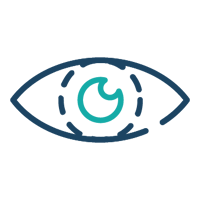Every year, approximately 800,000 individuals in the US experience a stroke, with 600,000 of those being new strokes. The location and severity of the stroke determine the outcome for the patient, including visual symptoms.
The visual system is particularly vulnerable to stroke due to the presence of millions of nerve fibers from each eye's optic nerve that course through and around the brain, even extending to the brainstem area. As a result, a stroke can have a significant effect on vision.
Stroke and Its Effects on Visual Function
A stroke can have a significant impact on vision. Depending on the location and severity of the stroke, a person may experience a range of visual problems. Some of the most common visual problems after a stroke include:
Spatial Inattention
One of the problems that stroke patients often experience is spatial inattention, which occurs when the brain shuts down on one side, typically the left side. The patient may not perceive information coming in from the left side and may not see items on the left side of a plate, for example. This is not a visual field deficit but is instead a result of the brain not perceiving information. This is when the brain shuts down on one side, typically the left, and the person does not perceive the space on that side.
Visual Field Defects
Another common problem after a stroke is a visual field defect, where a certain part of the brain is compromised, affecting the vision being directed on that side. Both spatial inattention and visual field defects can occur simultaneously, coming from different areas of the brain and affecting different processes. This is when a certain part of the brain is compromised and vision in that direction is affected.
Ocular Motor Dysfunction
This is when the person has difficulty moving their eyes or it's uncomfortable to do so.
Depth Perception and Navigating Space
Stroke patients may also experience difficulty with depth perception and navigating spaces. Mobility skills can be retrained using special lenses called prisms, which direct light into specific areas of the retina to activate and stimulate the brain. Our neuro optometrists are well-equipped to prescribe and dispense these prisms. A stroke can also affect a person's ability to perceive depth.
Double Vision
A person may also experience double vision after a stroke. There are several reasons why a stroke can cause double vision. It can be due to damage to the nerve pathways that control the eye muscles, or it can be a result of changes in the brain's ability to process visual information.
It is important to note that these visual problems may be temporary or permanent depending on the extent of the stroke. We can help stroke patients recover their visual function through rehabilitation and therapy.
Take our online double vision quiz
Is blurry, fuzzy, or double vision impacting your quality of life and vision? Take our online double vision assessment to help identify if you may have an underlying vision problem that is causing diplopia (double vision)
Reclaiming Your Vision After Stroke: The Role of Neuro Optometry
Rehabilitation after a brain injury can be a critical component of the patient's recovery process. It can begin soon after the injury and continue for an extended period of time, depending on the severity of the injury and the goals of the patient.
In the hospital setting, rehabilitation may include a variety of activities designed to help the patient regain functional abilities that were lost due to the injury. For example, in the case of visual field deficits, our neuro rehabilitation team may work with the patient to help them use the areas of their visual field that are still functioning well. This can involve activities to help the patient break down the visual spatial inattention and develop their awareness of the environment around them.
In addition, vision therapy can be effective in improving ocular motor dysfunction and double vision. We may use a range of techniques, including exercises to improve eye movements and coordination, and visual perception activities to help the patient learn to use their remaining vision to the best of their ability.
It's important to note that the severity and extent of a brain injury can vary greatly, and so too can the impact it has on the individual. In some cases, visual field deficits and other symptoms may be permanent, but rehabilitation can still help the patient improve their functional abilities and improve their overall quality of life.
Overall, neuro optometric rehabilitation is an essential component of the recovery process for individuals who have suffered a brain injury, and the focus should be on helping the patient achieve the best possible outcome.










